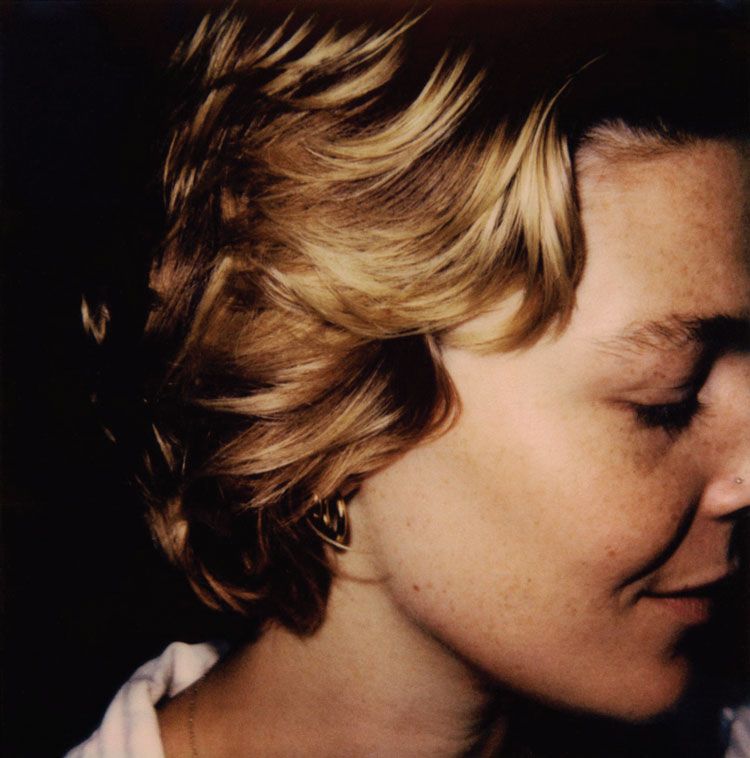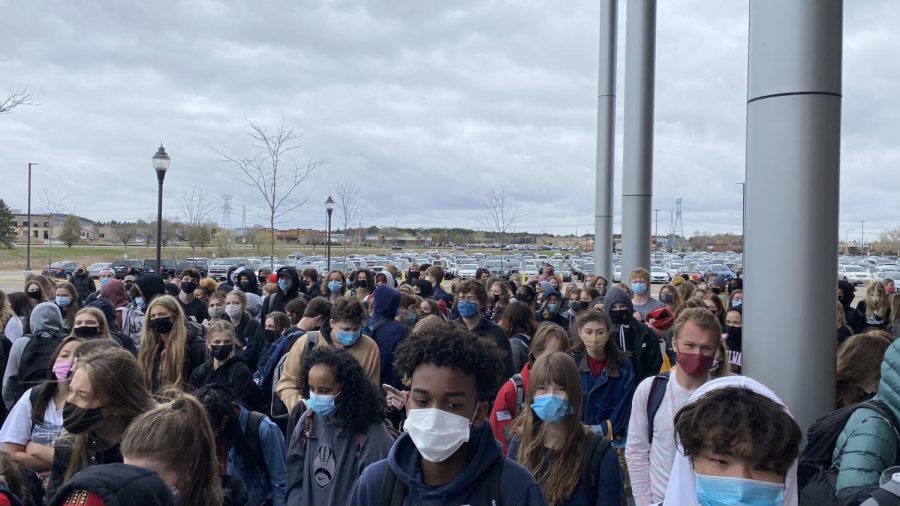Students walked out at the end of second period April 19 to protest and “stand in solidarity against police brutality,” read a flyer posted on social media. The walkout was organized by senior Will Raymond, who spoke alongside senior Gionna Carr.
Raymond initially had the idea for the walkout on April 15, learning later from a friend there was an organized statewide walkout on Monday.
Raymond initially wanted to host the walkout because it “turns out people care about people dying,” he said. Raymond added that the community needs to value each other as human beings. “I think a lot of people forget that it’s just another human telling another human, ‘Hey, you shouldn’t be allowed to kill someone just because you want to kill them,’” he said.
No one person, he continued, is “the judge, jury, and executioner. Even though, legally, a lot of times they’re allowed to. Which is very frustrating.”
Raymond ultimately said the purpose of the walkout was to encourage expression amongst his peers. The message of the walkout took its final form after Raymond learned of the statewide walkout. He narrowed the message to stand against police brutality, over-policing and systematic racism among police. Aside from the message itself, the next big hurdle was publicizing the protest as well as gaining approval from administration for the event.
Raymond initially wanted to hold the walkout during the break between fourth and sixth period, but conceded doing it in between second and fourth period because he felt it was the only thing Principal Rob Bach “was going to say yes to.” Even though Raymond felt this time did not interfere with class time, he agreed knowing it would achieve the goal on participation.
Raymond then passed around the flyer to Student Council presidents and shared it on social media. By the end of the weekend, students saw the message and knew to show up. The walkout, unbeknownst to Raymond and attendees, was on the eve of the jury verdict of the Derek Chauvin trial.
Carr initially wrote a poem after the killing of Ahmaud Arbery — an unarmed Black man killed by three white citizens out on a jog.
“That’s what sparked [the poem], but also just the other Black innocent lives that had been taken, and I just wanted to put my frustrations through my poetry,” Carr said.
However, Carr felt that this walkout was more broad than just over-policing and killings, she felt it was about support and finding out “who’s actually on your side.”
The poem was written with first hand-experience with a cop. Even though it was not a bad experience for her, she knew what could happen. Carr shared a story about when she was pulled over and mentioned her first thought being “please don’t shoot me.” Carr added, “Whatever this cop says, do it. I’m keeping my hands on the steering wheel and if I’m going to move my hands, I’m going to tell him.”
Cultural Liaison Cornelius Rish, highlighted a similar hypothetical in more blunt terms: “You get pulled over for a light being out, you get to go home to your family. I might not.”
Stillwater is still a largely white community with nearly 91% of the population Causasian. However, Rish said, “Stillwater is very reflective of many communities where you have the vast majority of the population in what I like to call ‘minimization.’”
Minimization, Rish continued, “is where people are in a state of ‘I love everybody. I don’t see color. I’m colorblind.’ When, in essence, we all do see color.”
Carr, Raymond and Rish all said there are still steps the district needs to take to create a safe learning environment. Rish still recounts experiences of students who hear the N-word in the hallway, hear monkey noises, and even experience racial trauma in the classroom without protection.
Rish said there needs to be a district-wide diversity and inclusion training, from the superintendent all the way down to the cafeteria staff, but said most importantly whatever is done needs to be not only “systematic, but for it to be consistent.” Carr also suggested having more mandated talks about race for students.
“Young adult voice has helped to create change in this country,” Rish said. “Students are our clients. When our clients are saying we’re not satisfied, because of x, y, and z, then we as educational leaders and teachers, have to listen.”
Both Carr and Raymond said Stillwater has a long way to go to create a safe and equitable learning environment. However, their legacy of wanting change hopefully will inspire others to advocate for themselves and others too.
“Other kids that are doing this type of work, leading peaceful protests and things like that,” Rish said. “They’re doing what I call legacy work. They may not reap the benefits of their work, but they can be doing it so that kids coming behind them may come to a safe learning environment.”
This story was originally published on The Pony Express on April 30, 2021.































![IN THE SPOTLIGHT: Junior Zalie Mann performs “I Love to Cry at Weddings,” an ensemble piece from the fall musical Sweet Charity, to prospective students during the Fine Arts Showcase on Wednesday, Nov. 8. The showcase is a compilation of performances and demonstrations from each fine arts strand offered at McCallum. This show is put on so that prospective students can see if they are interested in joining an academy or major.
Sweet Charity originally ran the weekends of Sept. 28 and Oct. 8, but made a comeback for the Fine Arts Showcase.
“[Being at the front in the spotlight] is my favorite part of the whole dance, so I was super happy to be on stage performing and smiling at the audience,” Mann said.
Mann performed in both the musical theatre performance and dance excerpt “Ethereal,” a contemporary piece choreographed by the new dance director Terrance Carson, in the showcase. With also being a dance ambassador, Mann got to talk about what MAC dance is, her experience and answer any questions the aspiring arts majors and their parents may have.
Caption by Maya Tackett.](https://bestofsno.com/wp-content/uploads/2024/02/53321803427_47cd17fe70_o-1-1200x800.jpg)
![SPREADING THE JOY: Sophomore Chim Becker poses with sophomores Cozbi Sims and Lou Davidson while manning a table at the Hispanic Heritage treat day during lunch of Sept 28. Becker is a part of the students of color alliance, who put together the activity to raise money for their club.
“It [the stand] was really fun because McCallum has a lot of latino kids,” Becker said. “And I think it was nice that I could share the stuff that I usually just have at home with people who have never tried it before.”
Becker recognizes the importance of celebrating Hispanic heritage at Mac.
“I think its important to celebrate,” Becker said. “Because our culture is awesome and super cool, and everybody should be able to learn about other cultures of the world.”
Caption by JoJo Barnard.](https://bestofsno.com/wp-content/uploads/2024/01/53221601352_4127a81c41_o-1200x675.jpg)






